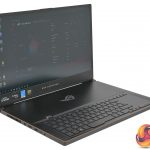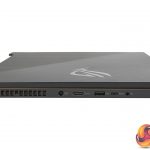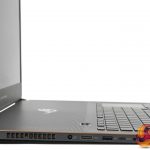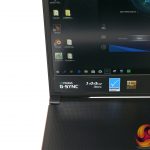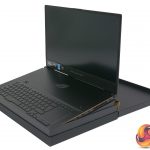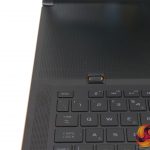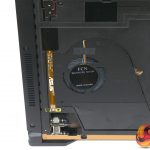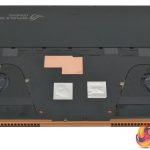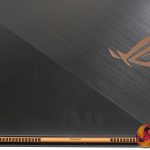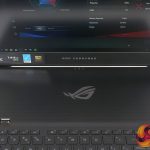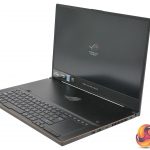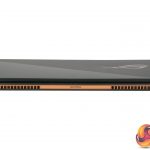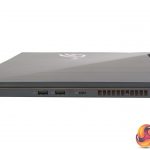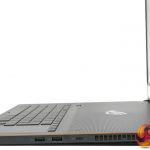Product highlights:
- Big Power in a Slim, Sleek Body
- Lifelike Visuals with Thin Bezels
- Exclusive GPU Switch Saves Battery Life
- Patented ROG Active Aerodynamic System
- Per-key RGB Lighting and Aura Sync
As we say in our video, there are three members of the GX701 family based on the same chassis, but with different specifications for the graphics. This GX701GX has RTX 2080 Max-Q graphics, GX701GW has RTX 2070 Max-P and GX701GV has RTX 2060 Max-P but will not be sold in the UK.
When you look down the specification of the GX701 you are bound to focus on the screen and graphics, however we were really impressed by the tiny footprint of the laptop. It is very easy to forget the GX701 packs a 17.3-inch screen as the chassis is so small.
The GX501 from 2017 measured 379mm x 262mm x 16.9mm and weighed 2.2kg. By contrast this GX701 is only slightly larger at 399mm x 272mm x 18.7mm, although it weights quite a bit more at 2.7kg.
This increase in weight is unexpected as Asus uses magnesium-alloy in the chassis and has clearly worked to keep weight down, so our guess is there is a fair amount of extra copper in the cooling system. We would love to be able to confirm that by getting inside the GX701 however this proved to be impossible.
When we reviewed the GX501 we were able to remove the keyboard and open the chassis without too much difficulty, although there were many ribbon cables that made it a delicate operation. With GX701 we could not figure out how to proceed and had to give up to avoid damaging the laptop.
No doubt there were some hidden latches or fasteners we missed but we were unable to get inside the chassis and see the RAM, SSD or battery, and this must surely mean owners of this laptop will find it difficult to upgrade in the future.
So Asus has made the chassis of GX701 impressively small and has reduced the screen bezel to a such an extent that is almost non-existent. To make this possible Asus has removed the webcam that was previously housed in the top screen bezel and supplies an external USB camera that clips to the screen/lid.
You can argue that this is inconvenient or you might see it as a way of getting a better web cam that you use once in a blue moon. This very much depends on your use case.
It is a similar story with the way Asus has removed the Ethernet port, forcing you to rely on a wireless connection. We can see the reasoning, honestly we can, but there are instances where Wi-Fi is less than ideal. For example, when you walk into the Press room at Computex you can either plug a cable in your laptop or you can look for the piece of paper that tells you the Wi-Fi password.
We know the world is heading towards ubiquitous Wi-Fi with devilish fast speeds but there are times when wired Ethernet is the easy option.
 KitGuru KitGuru.net – Tech News | Hardware News | Hardware Reviews | IOS | Mobile | Gaming | Graphics Cards
KitGuru KitGuru.net – Tech News | Hardware News | Hardware Reviews | IOS | Mobile | Gaming | Graphics Cards


